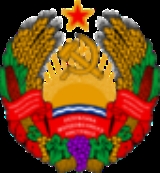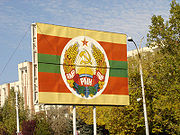
Coat of arms of Transnistria
Encyclopedia
The national emblem of Transnistria
is a remodeled version of the former Moldavian Soviet Socialist Republic emblem, that was substituted by the internationally-recognized Moldova
n government after the dissolution of the Soviet Union
in 1991. The only major change made in the Transnistrian device was the addition of waves, representing Dniester. Also the inscription on the red banner changed: unlike the Moldavian SSR emblem, which bore the acronym "РССМ" (for "Moldavian Soviet Socialist Republic") and the USSR state slogan Workers of the world, unite!
in Russian and Moldavian languages, the Transnistrian emblem bears the name "Pridnestrovian Moldavian Republic" in Moldovan
, Russian
and Ukrainian language
s. In Moldovan, it is "Република Молдовеняскэ Нистрянэ" (transliterated: "Republica Moldoveneascǎ Nistreanǎ"); in Russian, it is "Приднестровская Молдавская Республика" (transliterated: "Pridnestrovskaya Moldavskaya Respublika"); and, in Ukrainian, it is "Придністровська Молдавська Республіка" (transliterated: "Prydnistrovs'ka Moldavs'ka Respublika").

Transnistria
Transnistria is a breakaway territory located mostly on a strip of land between the Dniester River and the eastern Moldovan border to Ukraine...
is a remodeled version of the former Moldavian Soviet Socialist Republic emblem, that was substituted by the internationally-recognized Moldova
Moldova
Moldova , officially the Republic of Moldova is a landlocked state in Eastern Europe, located between Romania to the West and Ukraine to the North, East and South. It declared itself an independent state with the same boundaries as the preceding Moldavian Soviet Socialist Republic in 1991, as part...
n government after the dissolution of the Soviet Union
Dissolution of the Soviet Union
The dissolution of the Soviet Union was the disintegration of the federal political structures and central government of the Union of Soviet Socialist Republics , resulting in the independence of all fifteen republics of the Soviet Union between March 11, 1990 and December 25, 1991...
in 1991. The only major change made in the Transnistrian device was the addition of waves, representing Dniester. Also the inscription on the red banner changed: unlike the Moldavian SSR emblem, which bore the acronym "РССМ" (for "Moldavian Soviet Socialist Republic") and the USSR state slogan Workers of the world, unite!
Workers of the world, unite!
The political slogan Workers of the world, unite! is one of the most famous rallying cries of communism, found in The Communist Manifesto , by Karl Marx and Friedrich Engels...
in Russian and Moldavian languages, the Transnistrian emblem bears the name "Pridnestrovian Moldavian Republic" in Moldovan
Moldovan language
Moldovan is one of the names of the Romanian language as spoken in the Republic of Moldova, where it is official. The spoken language of Moldova is closer to the dialects of Romanian spoken in northeastern Romania, and the two countries share the same literary standard...
, Russian
Russian language
Russian is a Slavic language used primarily in Russia, Belarus, Uzbekistan, Kazakhstan, Tajikistan and Kyrgyzstan. It is an unofficial but widely spoken language in Ukraine, Moldova, Latvia, Turkmenistan and Estonia and, to a lesser extent, the other countries that were once constituent republics...
and Ukrainian language
Ukrainian language
Ukrainian is a language of the East Slavic subgroup of the Slavic languages. It is the official state language of Ukraine. Written Ukrainian uses a variant of the Cyrillic alphabet....
s. In Moldovan, it is "Република Молдовеняскэ Нистрянэ" (transliterated: "Republica Moldoveneascǎ Nistreanǎ"); in Russian, it is "Приднестровская Молдавская Республика" (transliterated: "Pridnestrovskaya Moldavskaya Respublika"); and, in Ukrainian, it is "Придністровська Молдавська Республіка" (transliterated: "Prydnistrovs'ka Moldavs'ka Respublika").


